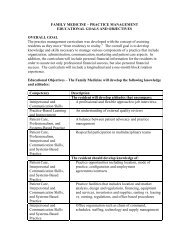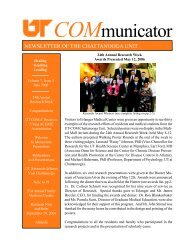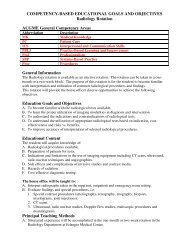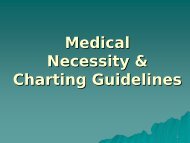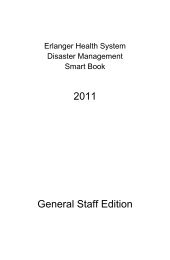Tube Feeding in Patients With Advanced Dementia
Tube Feeding in Patients With Advanced Dementia
Tube Feeding in Patients With Advanced Dementia
You also want an ePaper? Increase the reach of your titles
YUMPU automatically turns print PDFs into web optimized ePapers that Google loves.
TUBE FEEDING EFFECTIVENESS IN DEMENTIA<br />
ter pressure and <strong>in</strong>crease the risk of gastroesophageal<br />
reflux, with “a change <strong>in</strong><br />
the gastroesophageal angle (as) the suspected<br />
mechanism.” 4 No comparable<br />
studies have been reported <strong>in</strong> the elderly.<br />
A 1996 review of tube feed<strong>in</strong>g to prevent<br />
aspiration pneumonia conducted<br />
by 1 of the authors (T.E.F) and Bynum<br />
5 found that “No randomized trials<br />
of the <strong>in</strong>tervention have been done,<br />
and some data suggest <strong>in</strong>effectiveness.”<br />
A MEDLINE search from 1966<br />
through March 1999 us<strong>in</strong>g the same<br />
search terms as that article, enteral nutrition,<br />
deglutition disorders, and aspiration<br />
pneumonia, confirmed these observations.<br />
Three additional casecontrol<br />
studies identified tube feed<strong>in</strong>g<br />
as a risk factor for aspiration pneumonia<br />
and demonstrated high rates of<br />
pneumonia and death <strong>in</strong> tube-fed patients.<br />
6-8 In a nonrandomized, prospective<br />
study, 9 orally fed patients with oropharyngeal<br />
dysphagia had significantly<br />
fewer major aspiration events than<br />
those fed by tube. The authors conclude,<br />
“Artificial feed<strong>in</strong>g does not seem<br />
to be a satisfactory solution for prevent<strong>in</strong>g<br />
pneumonia <strong>in</strong> elderly prandial<br />
aspirators.” Jejunostomy is not associated<br />
with lower rates of pneumonia<br />
than gastrostomy. 10,11 We found no published<br />
studies suggest<strong>in</strong>g that tube feed<strong>in</strong>g<br />
can reduce the risk of aspiration<br />
pneumonia.<br />
DOES TUBE FEEDING PREVENT<br />
THE CONSEQUENCES OF<br />
MALNUTRITION<br />
Demented patients with problems eat<strong>in</strong>g<br />
frequently lose weight and develop<br />
other abnormal markers of nutritional<br />
status such as lowered serum album<strong>in</strong><br />
levels or total lymphocyte count, dim<strong>in</strong>ished<br />
triceps sk<strong>in</strong> fold or body mass <strong>in</strong>dex,orimpairedsk<strong>in</strong>-testreactivity.<strong>Tube</strong><br />
feed<strong>in</strong>g may then be <strong>in</strong>itiated to try to<br />
prevent or correct consequences of malnutrition<br />
<strong>in</strong>clud<strong>in</strong>g pressure ulcers, <strong>in</strong>fection,<br />
debility, and death.<br />
However, <strong>in</strong> several cl<strong>in</strong>ical situations,<br />
provision of <strong>in</strong>creased nutrients<br />
to patients with abnormal markers of<br />
nutritional state had no effect on mean<strong>in</strong>gful<br />
cl<strong>in</strong>ical outcomes. For 40 patients<br />
receiv<strong>in</strong>g tube feed<strong>in</strong>g <strong>in</strong> long-term care<br />
(the majority due to neurologic impairment),<br />
“adequate calories and prote<strong>in</strong><br />
were provided...still, subjects showed<br />
weight loss and severe depletion of lean<br />
and fat body mass. ...Despite adm<strong>in</strong>istration<br />
of apparently adequate formula,<br />
micronutrient deficiencies and<br />
marasmic malnutrition exist <strong>in</strong> chronically<br />
ill patients.” 12 In 2 additional cl<strong>in</strong>ical<br />
situations, patients with abnormal<br />
markers of nutritional status did not<br />
benefit from <strong>in</strong>creased adm<strong>in</strong>istration<br />
of nutrients. Of 17 trials study<strong>in</strong>g<br />
patients with advanced cancer, most of<br />
whom were emaciated, no trial showed<br />
a survival benefit from parenteral nutrition.<br />
13 Megestrol acetate <strong>in</strong> patients with<br />
acquired immunodeficiency syndrome<br />
(AIDS)–cachexia improved<br />
<strong>in</strong>take and nutritional markers; however,<br />
death rates <strong>in</strong> each of 4 treatment<br />
groups were more than double that of<br />
placebo controls. 14,15 For wast<strong>in</strong>g disorders<br />
associated with AIDS and cancer,<br />
a 1997 conference sponsored by the<br />
National Institutes of Health, the American<br />
Society for Parenteral and Enteral<br />
Nutrition, and the American Society for<br />
Cl<strong>in</strong>ical Nutrition concluded that “there<br />
are no published observations provid<strong>in</strong>g<br />
direct evidence that wast<strong>in</strong>g is a<br />
cause of death or that reversal of wast<strong>in</strong>g<br />
improves outcome.” 16<br />
For patients with advanced dementia<br />
and eat<strong>in</strong>g difficulties, the relationships<br />
among nutritional <strong>in</strong>take, markers<br />
of nutritional status, and cl<strong>in</strong>ically<br />
mean<strong>in</strong>gful outcomes rema<strong>in</strong> uncerta<strong>in</strong>.<br />
For some patients with catabolic illness,<br />
delivery of additional nutrients may<br />
not provide benefit. For others, additional<br />
nutrients might provide benefits,<br />
but these may be outweighed by<br />
adverse effects of tube feed<strong>in</strong>g. The relevant<br />
cl<strong>in</strong>ical question is whether tube<br />
feed<strong>in</strong>g improves outcomes putatively<br />
ascribed to malnutrition.<br />
IS SURVIVAL IMPROVED<br />
BY TUBE FEEDING<br />
We conducted a MEDLINE search of<br />
the terms survival and enteral nutrition<br />
from 1966 through March 1999 as well<br />
as the bibliographies of many articles<br />
related to these topics. Four l<strong>in</strong>es of evidence<br />
underm<strong>in</strong>e the apparently commonsense<br />
practice of tube feed<strong>in</strong>g emaciated,<br />
demented patients to prevent<br />
death due to starvation.<br />
First, survival of very low-weight,<br />
hand-fed demented patients can be substantial.<br />
Survival of demented and nondemented<br />
patients was not different <strong>in</strong><br />
a long-term care facility with a program<br />
ofcarefulfeed<strong>in</strong>gbyhand. 17 A2-yearprospective<br />
observation of 71 demented patients<br />
<strong>in</strong> long-term care found similar<br />
mortality rates among 4 groups: those<br />
who fed themselves, those who required<br />
assistance but otherwise had no eat<strong>in</strong>g<br />
difficulties, those who refused food, and<br />
those who coughed and choked on food.<br />
Only 1 patient was tube fed. 18<br />
Second, feed<strong>in</strong>g tube placement itself<br />
can cause death. Mortality dur<strong>in</strong>g<br />
percutaneous endoscopic gastrostomy<br />
(PEG) tube placement ranges<br />
from 0% to 2% 19,20 and perioperative<br />
mortality ranges from 6% to 24%. 21-25<br />
In a study of 882 fluoroscopic nasogastric<br />
tube placements, 3 patients died of<br />
arrhythmia dur<strong>in</strong>g the procedure. 26<br />
Third, mortality among tube-fed patients<br />
is substantial. Several retrospective<br />
studies describe survival after feed<strong>in</strong>g<br />
tube placement <strong>in</strong> patients with<br />
eat<strong>in</strong>g difficulties, although none are restricted<br />
to those with dementia. A review<br />
of studies of PEG tubes, each compris<strong>in</strong>g<br />
more than 50 patients, found<br />
mortality rates of 2% to 27% at 30 days<br />
and 50% or more at 1 year. 27 Mortality<br />
data from articles not <strong>in</strong>cluded <strong>in</strong> that<br />
review show 1-month mortality rates<br />
rang<strong>in</strong>g from 8% to 67%, and median<br />
survival appears to be well under 1 year<br />
(TABLE 1). The 2 largest studies <strong>in</strong>cluded<br />
7369 and 81 105 patients, respectively.<br />
The former reported that median<br />
survival after PEG tube placement<br />
was 7.5 months. 25 The latter found that<br />
63% of patients had died by 1 year after<br />
PEG or surgical gastrostomy tube placement<br />
and 81.3% were dead by 3 years. 23<br />
F<strong>in</strong>ally, nonrandomized, retrospective<br />
observations of nurs<strong>in</strong>g home residents<br />
have found no survival advantage<br />
with tube feed<strong>in</strong>g. No difference <strong>in</strong> sur-<br />
1366 JAMA, October 13, 1999—Vol 282, No. 14 ©1999 American Medical Association. All rights reserved.<br />
Downloaded from www.jama.com at MEDICAL LIB on December 15, 2008






